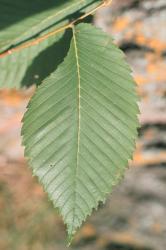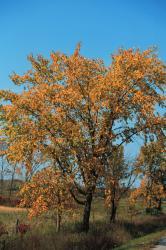June 11, 2013
| Ulmus americana American elm, White elm
|
| Description | Unmistakably elegant in shape, majestic when mature, the American elm is an exceptional tree for urban sites and will grow very rapidly even on the harshest of sites. Several resistant cultivars such as 'New Harmony' are proving to be moderately successful resisting Dutch Elm Disease. |
| Usage | Shade, street tree where maintenance budget includes monitoring. |
| Origin | Eastern and central North America |
| Hardiness zone | 2 |
| Size | 26-40m high x 20-40 wide. |
| Form/texture | Upright vase. |
| Growth rate | Fast. |
| Leaf | Dark green, yellow fall colour. |
| Flower | Inconspicuous, spring. |
| Fruit | Disc shaped samara, matures in spring. |
| Exposure/culture | Naturally found on alluvial flats. Shallow, wide spreading root system allows easy transplanting. Tolerant of poor drainage, high pH. Moderately tolerant to salt spray (Beckerman et al). |
| Comments | American elm will grow very rapidly even on the harshest of sites. It's tolerance and the unmistakable shape of the mature elm shows it to be an exceptional tree for urban use. Elms are easily propagated, easily produced and easily transplanted. Subject to several pests, diseases. Dutch Elm Disease (DED) remains a concern, but new cultivars such as 'New Harmony' show good resistance. Plant should be monitored for signs of disease. Even though elms may eventually succumb to DED, their urban lifespan and ultimate size may be better than some of the current well-used species. There could be a role for elms as fast, good street trees with a 25-year replacement schedule.
|


Reference:
Beckerman, J. and B.R. Lerner. 2009. Salt Damage in Landscape Plants. Purdue Extension Publication ID-412-W. Purdue University, West Lafayette, IN.
